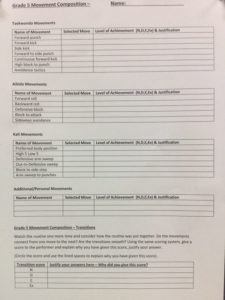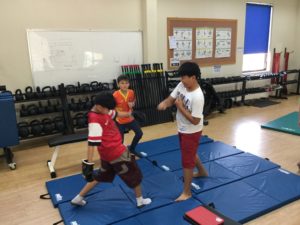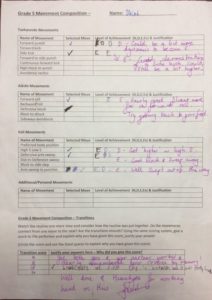Grade 5 – Movement Composition – Martial Arts
Grade 5 inquire in to a number of disciplines within martial arts before constructing their own performance composition.
Central idea: Movement patterns within physical activity and sports are constructed for a variety of reasons.
Key concepts: Form, change, connection Related concepts: Defence, attack, reflection
Lines of Inquiry: 1. Movement patterns related to specific disciplines 2. Constructing a performance composition 3. Creating and using assessment tools for compositions.
Session 1 – Inquiry in to Martial Arts Movements
I have taught this year level since they were in grade 2 so I thought I would give them a little flash back of video footage I still have of them completing Movement Composition units in the past. In grade 2 they created a dance video, in grade 3 they undertook a gymnastics unit and grade 4 saw the students try a new unit for me with a jump rope performance. I then talked about how I would like them to try a different type of movement composition unit and as we are blessed with good contacts here in Vientiane for different types of martial arts, we could benefit from the experience and expertise of others.
To get some discussion going, I asked them quickly discuss and name any type of martial arts they could. The common disciplines here in Vientiane and ones quickly listed were: Taekwondo, Muay Lao/Thai, Akido, Judo, Karate and Kick-boxing. Some students also added Mixed Martial Marts (MMA) and Kali (as one of our swimming instructors also teaches Kali after school). To get the group moving, I asked them to break up in to pairs and try and demonstrate any martial arts movements (kicks, punches, spins etc) they could to one-another. After about 5 minutes, I stopped the group and instructed them to take an iPad each (we are blessed with a set of PE iPads) and to repeat the same activity as before but this time they would video record one-another. By doing so, we could get a glimpse of the students prior knowledge and to record what they already know about martial arts before going any further in this unit. Below are some mix videos of the students working in pairs to demonstrate and record.
Following this, I asked the students to sit down with their iPads to upload their videos to Seesaw, an online digital portfolio that our school uses in primary to log and record our work. The students were asked to upload and comment about the purpose of the activity, which was to document their prior knowledge of martial arts movements before going further.
Session 2 – Inquiry in to Taekwondo Movements
Before beginning this session, I was able to confirm contact with 3 specialist martial arts instructors who could come to our school for sessions in Taekwondo, Akido and Kali. I therefore explained to the students that we would focus on the movements within those three disciplines plus any others previously known to construct our performance around. I wanted the students to undertake both inquiry and instruction based sessions and so to begin, I used session 2 as an inquiry based session, focused on Taekwondo with the following session using the expertise of the Taekwondo instructors.
The students were asked to work individually to begin and then in pairs to search for information with the iPads related to Taekwondo. They also needed to search for videos and examples of a Taekwondo movements and try to copy them and move along with the video. After about 10 minutes, I called the students in and asked them to work in pairs to practice and then video a short demonstration of any Taekwondo movements they learned which they could use later on in the lesson to share with other students or later on in the unit when constructing their own composition,
Students inquiring by searching for videos Trying, reviewing and trying again
With their videos recorded and finished, the students were called back to share their videos (if they wanted to) by pairing their iPad with an Apple TV box we have connected to a flat screen on the wall. The videos below are a mix of our lessons, from inquiring individually, to trying and working in pairs, recording and then those who wanted to share.
Session 3 – Taekwondo Specialist Lesson
Following the previous inquiry based session focusing on movements related to Taekwondo, I had organized specialist instructors to come in this week to demonstrate and teach some basic movements related to this discipline. I asked them to try and show a variety of movements from defence to attack and any avoidance tactics that might be used, from there I left it over to the instructors to lead the session. As it was a specialist session, I decided to take the two groups together and their class teachers allowed me to keep them for both lessons giving us plenty of time with our instructors.
The instructors began with a series of warm ups from stretches to stances and balancing positions. From there, they began with some punches, demonstrating basic forward punches first with the students copying the instructors movements. From there, some variations were added such as a side punch and a block-punch combination. The video below is a mix of the punches in the order they were taught in.
Following the punches, the instructors then took the students through a series of kicks. First they focused on a side kick before moving on to a forward kick, then switching stances before taking the students through a series of continuous kicks. The first video is a short video of the students practicing their side kicks and the second video is once again a mix highlighting the progression of the series of forward kicks.
With some time left, the instructors then focused on the movements of switching stances with a short game where the students had to switch their stance following a signal whilst continually bouncing on their toes. The final movement that was highlighted was that avoidance tactics and moving backwards away from an opponent. The videos below are short clips highlighting a part of each exercise mentioned above.
As the students will eventually be constructing their own routine using movements from any martial arts discipline they choose, I have recorded all of the demonstrations of kicks, punches, blocks etc which I share with the students through their class Google site. In that way, students will be able to access folders showing short clips of the movements from each discipline we focus on as they start to consider how they will construct their own routine. Also, I have started talking to the students about constructing a rubrics for this summative assessment task and asked them to start considering how they think their routines should be evaluated and if they could draw comparisons to any other sport where someone is judged or evaluated on a construction and demonstration of a routine.
Sessions 4 & 5 – Aikido Inquiry & Specialist Session
Moving on to a different discipline, we would now focus on Aikido and in a similar fashion to sessions 2 & 3, we would initially inquire before being taught by Aikido instructors. The students spent session 4 using their iPads to inquire in to the movements found and used in Aikido and again tried to copy the movements before recording themselves, viewing their movies and sharing with one-another. A few students again took some risks and shared with the whole group however I some how no longer have any of the photo or video footage from this lesson as it seems I cleaned up the iPads too quickly without saving everything properly this time.
Following the initial inquiry session, where students could get a brief introduction into Aikido we were lucky enough to have 4 guest Aikido instructors come and visit us. They began with a series of stretches and rolls to get the students moving.
Following the warm up, the instructors took the students through a series of forwards and backwards rolls as well as blocks and avoidance tactics. The instructors were able to explain to the students that many of the movements found in Aikido focused on how to avoid being attacked and self-preservation. The mix video below is a series of short clips of the movements that were taught as the lesson progressed.
We were also lucky enough to get a good look at the various Aikido movements in the form of a demonstration from some of the instructors. The first video is a sparring demonstration with the instructors moving at full speed which was rather impressive and got the students quite excited. The second video is a demonstration of various rolls that are used in Aikido and may be some movements students could use in their routines if they wish to incorporate them.
Session 6 – Kali Inquiry
At this point in time in the unit, my students have a good understanding of the way the next two lessons would operate. We would have a single lesson where the students make their own inquiries into the next martial arts discipline followed by a session with an instructor. Our next discipline to focus on is Kali, a Filipino style where again, a large focus area is that of avoidance, self-defence and self-preservation. This session was held in a different space to normal as our school was hosting an event this week but the students were still able to inquire using their iPads, copy movements and attempt sequences with partners. The videos below are mixed clips from various parts of the lessons.
Following the session in the courtyard, we moved upstairs to the Grade 5 classroom where we engaged in a discussion about the movements found within Kali. Some of the discussion focused on the defensive nature of Kali whilst other students found clips of careful choreography which they likened to a dance sequence. A couple of really inquisitive lads in my class discovered that Kali often involved using weapons such as knives and sticks and were hoping to be able to bring their own weapons from home for the session with the instructor the next day! Unfortunately for them I had to say no but nevertheless, everyone seemed quite excited for our next session. Before we left, some brave students decided to take part in sharing videos of their own first attempts by mirroring their iPad to the TV screen through the Apple TV box.
Showing videos of their first attempts at mimicking Kali movements.
Session 7 – Kali Specialist Session
With both grade 5 groups together for a double lesson, we had quite a bit of time to enjoy the instruction of Mr. Anthony who is a Kali instructor as well as a swimming coach at our school and quite well known to many of our students. With a rather entertaining approach, Mr. Anthony quickly grabbed the students attention as he started to introduce many of the basic movements found within Kali. With all of the movements he taught us, he began with a demonstration before allowing the students some time to try for themselves.
Mr. Anthony demonstrating a hold Students working in pairs to try the moves
Mr. Anthony began with demonstrating a preferred body position, to ensure a good line of vision before moving on to a “High five, low five” exercise which would then lead to blocks, sweeps, side steps and punches. The video below is again a mix of the different movements we covered as they were taught in the lesson.
I made sure we left about 10-15 minutes at the end of the lesson so we could reflect on the session from Mr. Anthony and hold a short discussion about their summative assessment task, creating their own martial arts movement composition. The reflection part could have gone on throughout break time as the students shared the many positives they enjoyed about the session and the teaching of Mr. Anthony. The use of weapons was once again discussed as students were wondering if they could be used in their own compositions they were to create. This lead me to discussing their own routine which was to be part of their summative assessment task and I had to begin by stating that no, unfortunately the students could not use weapons in their demonstrations, just to be sure. What I wanted them to now think about was the different movements from the disciplines we have covered and to consider what movements they would like to add in their routine.
To help them, I have compiled a series of videos that i took while our instructors were teaching the students in all of the instructor sessions as described above. I wanted to create a place where the students go visit and look through all of the videos to recall what we learned and to see a good demonstration of each movement. As grade 5 already use a Google classroom site, I uploaded the videos there so the students could access them through Google drive however, I have also uploaded them to this peswimstuff site in another blog post so the students could also visit them here. The link below will take you there if you wish to see these videos.
http://www.mrjoelpe.com/2017/02/02/martial-arts-videos/
Session 8 + 9 – Routine Construction
As we have covered the basic movements related to three different martial arts styles, the students will now turn their attention towards constructing their own routine. I had already explained to the students at the beginning of the unit that they were to use any of the movements covered or ones they already know from any other discipline to construct their own routine. They are to work with a partner and create a simulation where they demonstrate their movements of their choice. For example, one student could be demonstrating a Taekwondo punch as their partner demonstrates an Aikido block, then the simulation would continue from there. The minimum expectation was to include at least three manoeuvres with their video lasting at least 30 seconds, the longest to be 3 minutes.
As mentioned in the previous post, the students could view the moves from the three disciplines on my blog or their their class google site and as we had a number of specifically named movements, I decided to use these to construct our rubrics sheet. With regards to scoring the students performance, I felt that rather than using a subjective system and allocating points which would normally be done by experts, we might be able to evaluate a movement in a more simplified way. To achieve this, I used our report writing system where we score students as either ‘N’-Not Showing, ‘D’-Developing, ‘E’-Established and ‘EX’-Extending. By doing so, we would be able to view and pause student videos to compare to the examples we have from our instructors and therefore be able to compare where the students movements fell on the continuum. The photo below is the rubrics sheet I had prepared for the students to use in this session.
The students were to check the boxes in the first column to identify the movements they will use in their routine.
Once the students understood what they were to do, I let them get to work to initially consider their partners and the movements they might include in their routine. Once decided, they could try to begin choreographing their routine and even record themselves on an iPad if they chose to. If the students were still unsure of movements, they could refer back to the videos online to watch them again before adding to their routine or trying something different.
Students starting to choreograph their movements referring back to their rubrics sheets.
I let this lesson continue with the students working with their partners for the majority of the time. Some students decided to record their efforts and post them to our digital portfolios on Seesaw where their parents and others could begin to view their work. At the end of the lesson we had a quick discussion to gauge the progress of everyone’s compositions and it was clear the students were really interested in this task. Many of them had completed the majority of their routine within that first session and in the next lesson, they could sharpen their routine, record and upload it to Seesaw, ready for self, peer and teacher feedback.
The next lesson began where the students left off, with many of them getting straight into their groups to practice, reflect, readjust if necessary and then finally record their routine. The videos below are two mix clips of the students at various stages of their routine construction throughout this session.
Session 10 – Presentations and Assessment
As the majority of the students had completed recording their routines in one of the previous sessions, I instructed them to begin their self and then peer-assessment parts of the rubrics. The students were to watch their own routine and grade themselves along the continuum we use for our reporting system: N=Not Shown, D=Developing, E=Established and EX=Extending. The students would compare each martial arts move to that of the instructors for an example of an Extended demonstration. After completing their own, they could exchange papers and devices and complete the peer assessment part of the document.
The videos below are some of the routines that demonstrated more fluent movements and connections between each individual move. Instead of just demonstrating one move at a time, they understood the task and created a composition that flowed together from one movement to the next, the majority of the time!
Students selected their moves on the rubrics
They had to complete a self and peer assessment viewing of the routine
Finally, the teacher reflection and comments were added.
Both rubrics and video were uploaded to Seesaw to share with students and families




















